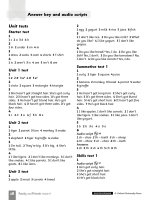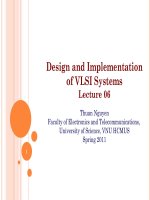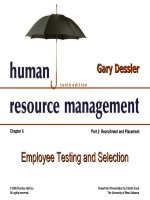Dessler HRM 12e ch 06 employee testing and sellection
Bạn đang xem bản rút gọn của tài liệu. Xem và tải ngay bản đầy đủ của tài liệu tại đây (666.4 KB, 39 trang )
Chapter 6
Employee Testing
and Selection
Part Two | Recruitment and Placement
Copyright © 2011 Pearson Education, Inc.
publishing as Prentice Hall
PowerPoint Presentation by Charlie Cook
The University of West Alabama
WHERE WE ARE NOW…
Copyright © 2011 Pearson Education, Inc. publishing as Prentice Hall
6–2
LEARNING OUTCOMES
1. Explain what is meant by reliability and validity.
2. Explain how you would go about validating a test.
3. Cite and illustrate our testing guidelines.
4. Give examples of some of the ethical and legal
considerations in testing.
5. List eight tests you could use for employee selection
and how you would use them.
6. Give two examples of work sample/simulation tests.
7. Explain the key points to remember in conducting
background investigations.
Copyright © 2011 Pearson Education, Inc. publishing as Prentice Hall
6–3
Why Careful Selection is Important
The Importance of Selecting
the Right Employees
Organizational
performance
Costs of recruiting
and hiring
Copyright © 2011 Pearson Education, Inc. publishing as Prentice Hall
Legal obligations
and liability
6–4
Avoiding Negligent Hiring Claims
• Carefully scrutinize information on employment
applications.
• Get written authorization for reference checks, and
check references.
• Save all records and information about the applicant.
• Reject applicants for false statements or conviction
records for offenses related to the job.
• Balance the applicant’s privacy rights with others’
“need to know.”
• Take immediate disciplinary action if problems arise.
Copyright © 2011 Pearson Education, Inc. publishing as Prentice Hall
6–5
Basic Testing Concepts
• Reliability
Describes the consistency of scores obtained by the same
person when retested with the identical or alternate forms of the
same test.
Are test results stable over time?
• Validity
Indicates whether a test is measuring what it is supposed to be
measuring.
Does the test actually measure what it is intended to measure?
Copyright © 2011 Pearson Education, Inc. publishing as Prentice Hall
6–6
FIGURE 6–1
A Slide from the Rorschach Test
Copyright © 2011 Pearson Education, Inc. publishing as Prentice Hall
6–7
Types of Validity
Types of
Test Validity
Criterion validity
Copyright © 2011 Pearson Education, Inc. publishing as Prentice Hall
Content validity
6–8
Evidence-Based HR: How to Validate a Test
Steps in Test Validation
1
Analyze the Job: predictors and criteria
2
Choose the Tests: test battery or single test
3
Administer the Test: concurrent or predictive validation
4
Relate Your Test Scores and Criteria: scores versus
actual performance
5
Cross-Validate and Revalidate: repeat Steps 3 and 4
with a different sample
Copyright © 2011 Pearson Education, Inc. publishing as Prentice Hall
6–9
FIGURE 6–2
Examples of Web Sites Offering Information
on Tests or Testing Programs
• www.hr-guide.com/data/G371.htm
Provides general information and sources
for all types of employment tests
•
Provides technical information on all types
of employment and nonemployment
• tests.www.ets.org/testcoll
Provides information on over 20,000 tests
• www.kaplan.com
Information from Kaplan test preparation
on how various admissions tests work
• www.assessments.biz
One of many firms offering employment tests
Copyright © 2011 Pearson Education, Inc. publishing as Prentice Hall
6–10
FIGURE 6–3
Expectancy Chart
Note: This expectancy chart shows the
relation between scores made on the
Minnesota Paper Form Board and rated
success of junior draftspersons.
Example: Those who score between 37
and 44 have a 55% chance of being
rated above average and those scoring
between 57 and 64 have a 97% chance.
Copyright © 2011 Pearson Education, Inc. publishing as Prentice Hall
6–11
TABLE 6–1
Testing Program Guidelines
1. Use tests as supplements.
2. Validate the tests.
3. Monitor your testing/selection program.
4. Keep accurate records.
5. Use a certified psychologist.
6. Manage test conditions.
7. Revalidate periodically.
Copyright © 2011 Pearson Education, Inc. publishing as Prentice Hall
6–12
Test Takers’ Individual Rights
and Test Security
• Under the APA’s standard for educational and
psychological tests, test takers have the following
rights:
The right to the confidentiality of test results.
The right to informed consent regarding use of these results.
The right to expect that only people qualified to interpret the
scores will have access to them, or that sufficient information
will accompany the scores to ensure their appropriate
interpretation.
The right to expect the test is fair to all. For example, no one
taking it should have prior access to the questions or
answers.
Copyright © 2011 Pearson Education, Inc. publishing as Prentice Hall
6–13
Legal Privacy Issues
• Defamation
Libeling or slandering of employees or former employees
by an employer.
• Avoiding Employee Defamation Suits
1. Train supervisors regarding the importance of employee
confidentiality.
2. Adopt a “need to know” policy.
3. Disclose procedures impacting confidentially of information
to employees.
Copyright © 2011 Pearson Education, Inc. publishing as Prentice Hall
6–14
How Do Employers Use Tests at Work?
• Major Types of Tests
Basic skills tests
Job skills tests
Psychological tests
• Why Use Testing?
Increased work demands = more testing
Screen out bad or dishonest employees
Reduce turnover by personality profiling
Copyright © 2011 Pearson Education, Inc. publishing as Prentice Hall
6–15
FIGURE 6–4
Sample Test
Copyright © 2011 Pearson Education, Inc. publishing as Prentice Hall
6–16
Computerized and Online Testing
• Online tests
Telephone prescreening
Offline computer tests
Virtual “inbox” tests
Online problem-solving tests
• Types of Tests
Specialized work sample tests
Numerical ability tests
Reading comprehension tests
Clerical comparing and checking tests
Copyright © 2011 Pearson Education, Inc. publishing as Prentice Hall
6–17
Types of Tests
What Different Tests Measure
Cognitive
abilities
Motor and
physical abilities
Copyright © 2011 Pearson Education, Inc. publishing as Prentice Hall
Personality
and interests
Current
achievement
6–18
FIGURE 6–5
Type of Question Applicant Might Expect
on a Test of Mechanical Comprehension
Copyright © 2011 Pearson Education, Inc. publishing as Prentice Hall
6–19
The “Big Five”
Extraversion
Conscientiousness
Agreeableness
Copyright © 2011 Pearson Education, Inc. publishing as Prentice Hall
Emotional stability/
Neuroticism
Openness to
experience
6–20
Work Samples and Simulations
Measuring Work Performance
Directly
Work
samples
Management
assessment
centers
Copyright © 2011 Pearson Education, Inc. publishing as Prentice Hall
Video-based
situational
testing
Miniature job
training and
evaluation
6–21
FIGURE 6–7
Example of a Work Sampling Question
Checks key before installing against:
___ shaft
score 3
___ pulley
score 2
___ neither
score 1
Note: This is one step in installing pulleys and belts.
Copyright © 2011 Pearson Education, Inc. publishing as Prentice Hall
6–22
TABLE 6–2
Evaluation of Assessment Methods on Four Key Criteria
Assessment Method
Validity
Adverse Impact
Costs (Develop/
Administer)
Applicant Reactions
Cognitive ability tests
High
High (against minorities)
Low/low
Somewhat favorable
Job knowledge test
High
High (against minorities)
Low/low
More favorable
Personality tests
Low to
moderate
Low
Low/low
Less favorable
Biographical data inventories
Moderate
Low to high for different
types
High/low
Less favorable
Integrity tests
Moderate to
high
Low
Low/low
Less favorable
Structured interviews
High
Low
High/high
More favorable
Physical fitness tests
Moderate to
high
High (against females and
older workers)
High/high
More favorable
Situational judgment tests
Moderate
Moderate (against
minorities)
High/low
More favorable
Work samples
High
Low
High/high
More favorable
Assessment centers
Moderate to
high
Low to moderate,
depending on exercise
High/high
More favorable
Physical ability tests
Moderate to
high
High (against females and
older workers)
High/high
More favorable
Note: There was limited research evidence available on applicant reactions to situational judgment tests and physical ability tests. However,
because these tests tend to appear very relevant to the job, it is likely that applicant reactions to them would be favorable.
Copyright © 2011 Pearson Education, Inc. publishing as Prentice Hall
6–23
Background Investigations and
Other Selection Methods
• Investigations and Checks
Reference checks
Background employment checks
Criminal records
Driving records
Credit checks
• Why?
To verify factual information provided by applicants
To uncover damaging information
Copyright © 2011 Pearson Education, Inc. publishing as Prentice Hall
6–24
Background Investigations and
Reference Checks
Former Employers
Current Supervisors
Sources of
Information
Commercial Credit
Rating Companies
Written References
Social Networking Sites
Copyright © 2011 Pearson Education, Inc. publishing as Prentice Hall
6–25









